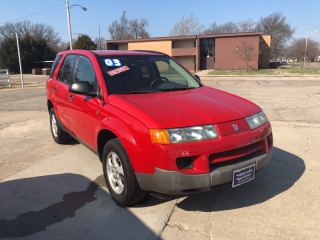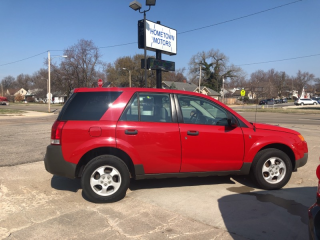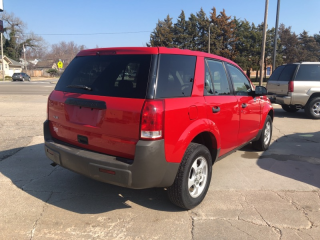The Good
The 2003 Saturn VUE offered practical advantages like a versatile, spacious interior and good fuel economy for its class (especially the 4-cylinder). The optional V6 provided adequate performance. For emotional buyers, its distinctive dent-resistant plastic body panels and the "no-haggle" Saturn buying experience were appealing, alongside its strong value proposition in the compact SUV segment.
The Bad
Known weaknesses for the 2003 Saturn VUE primarily include serious transmission issues, particularly with the VTi (CVT) and early 4-speed automatics. Owners also report common power steering pump failures, some engine oil consumption for the 4-cylinder, and interior build quality concerns. Road noise can be prominent at highway speeds.
2003 Saturn VUE: Quick Overview
The 2003 Saturn VUE offered a range of specifications designed to appeal to various buyers, from economical commuters to those needing more power and all-weather capability.
- Engine Options: The VUE was available with two primary engine choices: the 2.2-liter "Ecotec" inline-4 and a 3.0-liter L81 V6. The Ecotec was a modern, all-aluminum engine, while the V6 was a larger, more powerful option for those seeking enhanced performance.
- Horsepower: The 2.2-liter Ecotec I4 engine produced 143 horsepower and 152 lb-ft of torque. The 3.0-liter V6 engine delivered 181 horsepower and 195 lb-ft of torque. These figures placed the VUE competitively within its class for the time.
- Fuel Economy: Fuel efficiency varied based on engine and drivetrain. The 2.2L I4 FWD with a manual transmission achieved an estimated 22 MPG city / 28 MPG highway. With the automatic transmission, the I4 FWD was rated around 20 MPG city / 26 MPG highway. The V6 FWD with automatic transmission offered approximately 19 MPG city / 25 MPG highway, while the V6 AWD automatic was rated at 18 MPG city / 24 MPG highway.
- 0-60 MPH Times: Performance was adequate for a compact SUV. The 2.2L I4 typically managed 0-60 mph in the range of 9.5 to 10.5 seconds, depending on the transmission and drivetrain. The more powerful 3.0L V6 significantly improved acceleration, with 0-60 mph times closer to 8.5 to 9.0 seconds.
- Towing Capacity: When properly equipped with the optional towing package, the V6-powered 2003 Saturn VUE boasted a towing capacity of up to 3,500 pounds, making it suitable for light trailers or recreational vehicles. The 4-cylinder model had a lower towing capacity, generally around 1,500 pounds.
- Trim-Level Features: The 2003 VUE didn't have distinct "trims" in the traditional sense but offered various configurations based on engine, drivetrain (FWD or AWD), and transmission. Standard features typically included air conditioning, an AM/FM stereo, and power mirrors. Optional features and packages could add power windows, power door locks, remote keyless entry, cruise control, a CD player, alloy wheels, a roof rack, anti-lock brakes (ABS), traction control, and side airbags. The interior emphasized practicality, with durable cloth upholstery and a cargo area featuring a removable rear cargo organizer.
2003 Saturn VUE Specifications
Vehicle Information
| Year | 2003 |
| Make | Saturn |
| Model | VUE |
| Trim | - |
| Style | Front-Wheel Drive 5-Speed Manual |
| Type | Sport Utility Vehicle |
| Category | Standard Sport Utility Vehicle |
Manufacturing Details
| Made In | United States |
| Manufacturing City | SPRINGHILL |
Dimensions
| Doors | 4-Door |
| Curb Weight | 3491 pounds |
| Gross Vehicle Weight Rating | - |
| Overall Height | 66.40 inches |
| Overall Length | 181.30 inches |
| Overall Width | 71.60 inches |
| Wheelbase Length | 106.60 inches |
| Standard Seating | 5 |
Engine & Performance
| Engine | 3.0-L V-6 DOHC 24V |
| Engine Size | 3L |
| Engine Cylinders | 6 |
| Transmission | 5-Speed Manual |
| Transmission Type | Manual |
| Transmission Speeds | 5-Speed |
| Drivetrain | All-Wheel Drive |
Additional Features
| Anti-Brake System | Non-ABS 4-Wheel ABS |
| Steering Type | Rack & Pinion |
Pricing
| Manufacturer Suggested Retail Price (MSRP) | $22,910 |
| Invoice Price | $15,226 |
| Delivery Charges | $575 |
Vehicle History Report
Specifications
History
Events
History Check
Check
Check
Check
Check
Listings
Recalls
Check
Analysis
What Problems Does the 2003 Saturn VUE Have?
Another common complaint revolves around the power steering system. Failures of the power steering pump and associated leaks are frequently reported, leading to a loss of power assist and requiring significant repairs. The 2.2-liter Ecotec 4-cylinder engine, while generally reliable, has been known for excessive oil consumption and some instances of premature timing chain wear, which can be an expensive fix if not addressed early. The V6 engine is generally more robust but not immune to issues.
Beyond powertrain concerns, owners often report problems with suspension components, such as worn control arm bushings, ball joints, and struts, leading to clunking noises and poor ride quality. Electrical gremlins are also not uncommon, manifesting as issues with window regulators, HVAC controls, dashboard lights, and radio malfunctions.
Regarding recalls, the 2003 Saturn VUE has had a few. Notable recalls include issues related to the power steering hose coming in contact with the exhaust manifold (NHTSA Campaign ID: 05V042000), potentially causing leaks and fires. Other recalls involved seat belt retractors and anti-lock brake system (ABS) module concerns, though these varied by specific build dates and configurations. While the polymer body panels are dent-resistant, they can develop squeaks and rattles over time, and color matching after repair can be challenging. Overall, the transmission issues stand out as the most significant long-term reliability concern for the 2003 VUE, making a thorough pre-purchase inspection crucial for any interested buyer.
How long will the 2003 Saturn VUE last?
What Technology & Safety Features are Included?
Built-in Tech & Entertainment:
Standard tech was fairly basic. All models included an AM/FM stereo. An optional upgrade was an AM/FM stereo with a CD player. Beyond this, there were no advanced infotainment screens, navigation systems, or connectivity options like Bluetooth. Basic climate control was standard, and optional features included power windows, power door locks, remote keyless entry, and cruise control, which provided convenience features that are standard on most vehicles today. The gauge cluster was simple and functional, displaying essential information.
Driver-Assistance Features:
In 2003, driver-assistance technology was rudimentary. The VUE did not offer features such as adaptive cruise control, lane-keeping assist, blind-spot monitoring, or automatic emergency braking. The most advanced "assistance" came in the form of optional Anti-lock Braking System (ABS) and traction control, which improved stability and stopping power under challenging conditions.
Safety Features:
Standard safety equipment included dual front airbags for the driver and front passenger. Side-impact airbags were an available option, offering additional protection in side-on collisions. Three-point seatbelts for all outboard seating positions and child seat anchors (LATCH system) were also standard. As mentioned, ABS and traction control were optional, often bundled together. The polymer body panels, while known for dent resistance, also contributed to the vehicle's overall structural integrity.
Crash-Test Ratings:
The 2003 Saturn VUE performed commendably in crash tests for its time. From the National Highway Traffic Safety Administration (NHTSA), the VUE received:
- Frontal Crash: Five out of five stars for the driver and four out of five stars for the front passenger.
- Side Crash: Five out of five stars for front occupants and four out of five stars for rear occupants (reflecting its robust side-impact protection, especially with optional side airbags).
What Colors Options are Available?
2003 Saturn VUE Prices and Market Value
Depreciation has been steep for the VUE. The discontinuation of the Saturn brand, combined with widespread concerns over transmission reliability, particularly the VTi (CVT), has severely impacted its resale value. Factors affecting its current resale value include engine type (V6 generally preferred), transmission type (manual or traditional automatic favored over CVT), overall mechanical condition, and the presence of complete service records. Low mileage and excellent cosmetic condition can help, but the historical reliability issues remain a major deterrent.
2003 Saturn VUE Cost of Ownership
2003 Saturn VUE Fuel Efficiency
2003 Saturn VUE Safety Rating
NHTSA
IIHS
2003 Saturn VUE Warranty
Basic
Powertrain
Rust
2003 Saturn VUE Insurance
reasonable repair costs.
How Does the 2003 Saturn VUE Compare to Other Sport Utility Vehicle?
In terms of performance, the VUE's optional 3.0-liter V6 offered competitive power, often matching or slightly exceeding the V6 options in the Ford Escape or Hyundai Santa Fe. However, its base 2.2-liter 4-cylinder was generally less refined and felt less potent than the engines found in the Honda CR-V or Toyota RAV4, which were known for their peppy 4-cylinder offerings. The VUE's handling was generally considered competent but not sporty.
Regarding features, the VUE was comparable to base models of its rivals, offering essentials like air conditioning and an optional CD player. However, it typically lagged behind the more upscale interiors and advanced (for the time) features found in top-trim CR-Vs or RAV4s. Its interior, while practical and spacious, often felt less refined due to lower-quality plastics.
Reliability is where the VUE faced its most significant challenge. While the Honda CR-V and Toyota RAV4 of this era are legendary for their long-term dependability, the 2003 VUE suffered from notorious transmission issues, especially the VTi (CVT), which dramatically hampered its reliability scores. Even the conventional automatics had problems. This puts its reliability considerably below the Japanese rivals and often below the Ford Escape or Hyundai Santa Fe, though these American and Korean competitors weren't entirely without their own mechanical quirks.
Price was a key selling point. When new, the VUE was often more affordably priced than the CR-V or RAV4, appealing to budget-conscious buyers. On the used market today, this price difference is even more pronounced due to its depreciation, making it one of the cheapest options in its class.
Recommended Alternatives:
- For superior reliability: The 2003 Honda CR-V (RD generation) or Toyota RAV4 (XA20 generation) are unequivocally better choices, known for their robust engines and transmissions, and excellent resale value.
- For similar performance and value: The 2003 Ford Escape or Hyundai Santa Fe offer comparable V6 performance and feature sets, often at a slightly higher reliability perception than the VUE, but still warrant a thorough inspection.
Final Verdict: Is the 2003 Saturn VUE a Good Sport Utility Vehicle?
Is it worth buying today? Yes, but under very specific conditions. It is absolutely crucial to avoid any VUE equipped with the problematic VTi (CVT) transmission. Instead, focus on models with the 3.0-liter V6 engine paired with the traditional 4-speed automatic, or ideally, a 4-cylinder model with a rare manual transmission. A comprehensive pre-purchase inspection by a trusted mechanic, specifically checking the transmission and power steering system, is non-negotiable. This vehicle is best considered as a cheap, used secondary vehicle or for someone needing short-term utility with a low initial investment. It is not recommended for buyers seeking long-term, worry-free ownership without a clear history of meticulous maintenance and absence of past major transmission issues.



